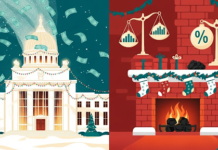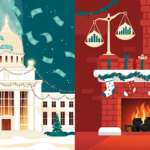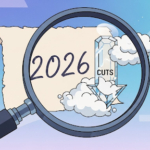The Fed is at a crossroads. Higher egg prices could be a warning sign for what’s next.
Egg prices are soaring again—and they’re more than just a grocery-store nuisance. They’re becoming a symbol of the Federal Reserve’s growing challenge in controlling inflation. With costs for a dozen eggs surging 62.3% year-over-year, the Fed’s carefully planned strategy to lower inflation without derailing economic growth is hitting a speed bump.
While inflation has cooled from its 2022 highs, the “last mile” of the fight is proving tougher than expected. Supply chain shocks, global trade risks, and consumer sentiment are all complicating the outlook. Fed officials had hoped for a smooth path downward, but markets are beginning to wonder: Is inflation about to make a comeback?
This week, we’re cracking open the issue (pun intended). In our main story, we examine how rising egg prices, tariffs, and stubborn inflation expectations could shape the Fed’s next move—and whether interest rate cuts are still on the table.
Let’s dive in.
This Week I Learned…
The “Eggspectation” Trap: How Consumer Perception Fuels Inflatio
Inflation isn’t just about numbers—it’s about psychology. If people expect prices to rise, they actually help push inflation higher. It’s a self-fulfilling cycle, and egg prices are a perfect example of how it works.
Here’s how: when consumers see staple goods like eggs and gas becoming more expensive, they assume other prices will follow. This leads to demands for higher wages, which forces businesses to raise prices to cover costs, and the inflation cycle continues.
The Fed is extremely wary of this “expectation trap.” If enough consumers believe inflation is coming back, businesses will respond accordingly, and suddenly, inflation isn’t just a temporary problem—it’s embedded into the economy.
In fact, the San Francisco Fed found that short-term inflation fears directly impact wage negotiations. If workers expect prices to rise, they’ll push for bigger paychecks. Companies, in turn, increase prices, making inflation worse.
This is why Fed Chair Jerome Powell watches consumer expectations closely. If people think inflation is cooling, it actually helps inflation cool down. But if everyday costs—like eggs—keep rising, those expectations could spiral out of control.
Bottom line? The cost of breakfast might be shaping the future of interest rates.
The Fun Corner
Why did the investor refuse to buy eggs?
Because they were already “over-easy” on inflation expectations!
Okay, maybe not the best joke—but egg prices are no laughing matter. Historically, staple goods like eggs, milk, and gas are some of the most closely watched indicators of consumer sentiment. If prices spike, people panic. If prices drop, confidence rises.
One fun fact? In 1973, the U.S. even considered rationing eggs due to inflation. That’s how much of an economic symbol they’ve become!
Moral of the story: Your breakfast choices might be a leading indicator of economic trends.
Is the Fed Losing Its Grip on Inflation?
Egg Prices, Tariffs, and the Fed’s “Last Mile” Problem
Just when the Federal Reserve thought inflation was cooling, higher egg prices, supply shocks, and trade risks are throwing new uncertainty into the mix.
For months, Fed officials have taken comfort in inflation dropping from 7.2% to 2.5%, all while the labor market remained strong. With progress like that, they felt confident enough to cut interest rates by 100 basis points over the past year.
But recent data suggests that inflation might not be as under control as they hoped.
Egg prices have skyrocketed 62.3% year-over-year, thanks to an avian flu outbreak that has forced millions of hens out of production. While this is technically a supply shock—a one-time event rather than a broader inflation trend—the Fed has learned the hard way not to dismiss “temporary” price spikes.
In 2021, inflation was also dismissed as “transitory.” That mistake led to aggressive rate hikes in 2022 and 2023, shaking markets and pushing borrowing costs to their highest levels in decades. Now, the Fed doesn’t want to make the same mistake again.
Why Egg Prices Matter to Inflation Expectations
It’s not just about eggs. When consumers see key grocery items rising in price, they start to assume inflation is picking up again. That’s why Fed officials are paying close attention.
A University of Michigan survey found that consumer inflation expectations in February hit their highest level since late 2023. If those expectations become entrenched, the Fed may have to pause rate cuts—or even consider raising rates again.
The Trump Tariff Factor
On top of this, potential new tariffs from Donald Trump’s proposed policies could act as a second inflationary force. Tariffs raise import costs, which then get passed to consumers. Economists are already debating whether trade policies could undo the Fed’s inflation progress.
What’s Next?
For now, the Fed is holding steady on interest rates, but Powell and his team know that consumer expectations could force their hand. If prices remain elevated and inflation expectations climb, markets may have to reconsider the odds of a rate cut this year.
The next few months will be critical. If inflation data remains hot, rate cuts could be off the table. If it cools? The Fed might stay on track. Either way, the cost of breakfast could be shaping economic policy.
The Last Say
Inflation, Expectations, and a High-Stakes Balancing Act
Inflation isn’t just about numbers—it’s about perception. Right now, the Fed is fighting two battles: actual price increases and consumer expectations.
If people expect inflation to rise, they push for higher wages, which forces businesses to increase prices, which then fuels more inflation. That’s why something as simple as egg prices can have a bigger impact than you’d think.
Right now, Powell and the Fed are trying to stay patient. They don’t want to raise rates again, but they also can’t afford to let inflation expectations spiral. Meanwhile, looming trade policies and supply chain issues are adding more uncertainty.
For investors, this means watching inflation data closely. If price pressures remain stubborn, markets may have to rethink their bets on rate cuts. If inflation cools, the Fed may still move ahead with easing later this year.
Either way, one thing is clear: What happens in your grocery store aisle could shape what happens on Wall Street.






















